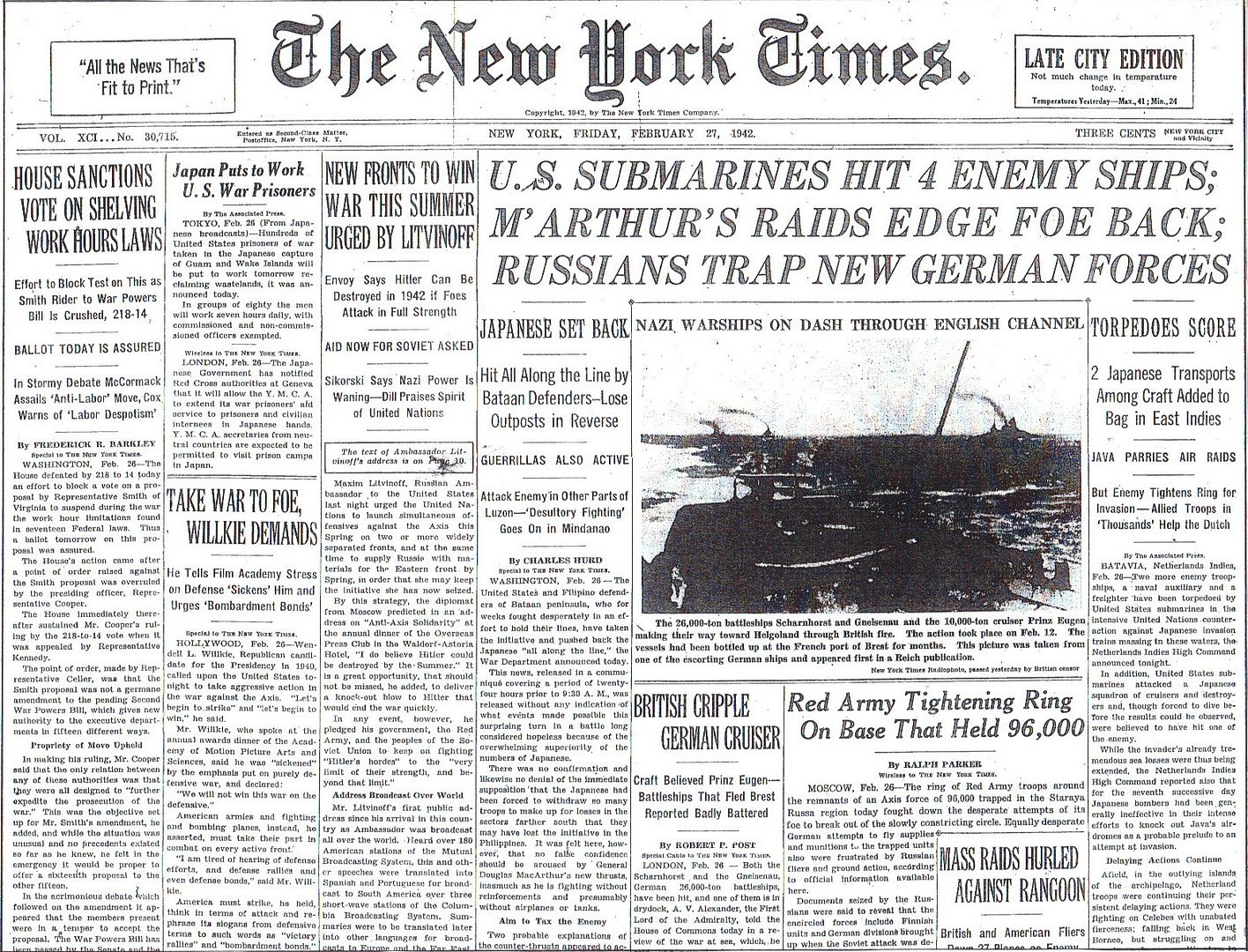
Posted on 02/27/2012 4:26:18 AM PST by Homer_J_Simpson

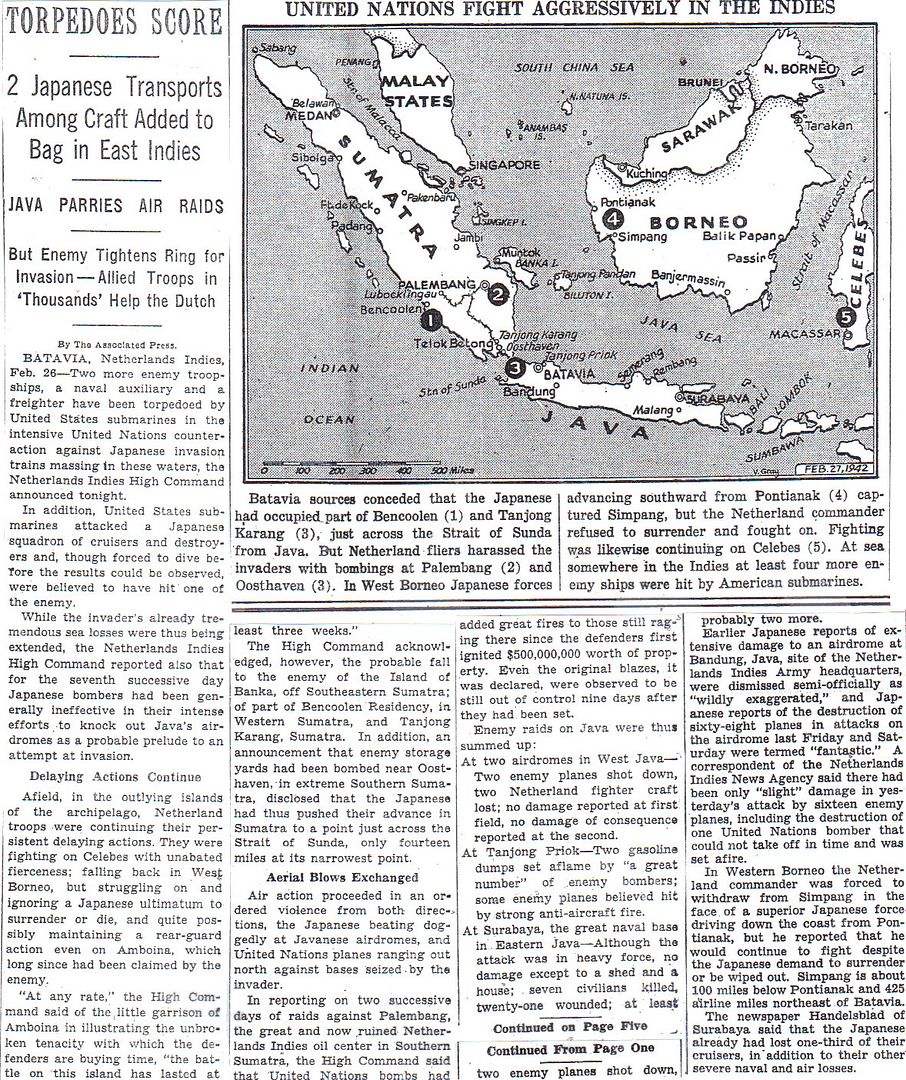

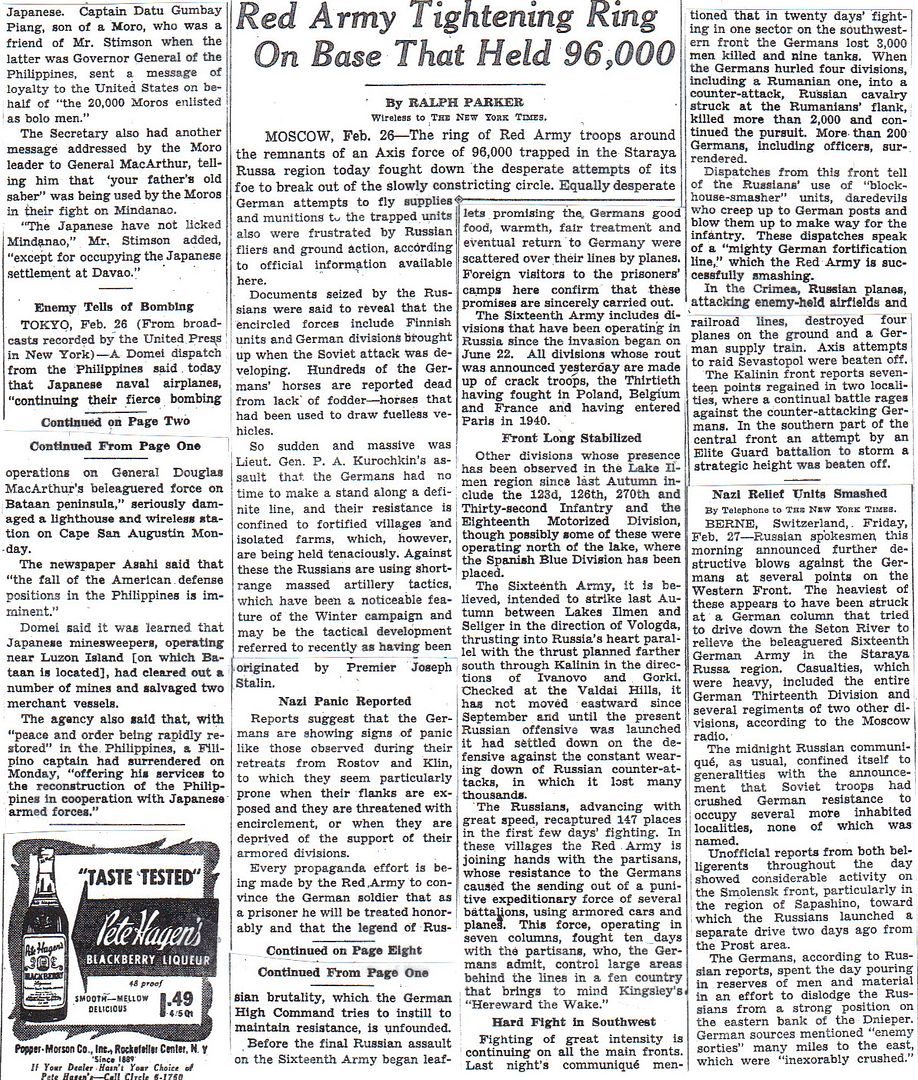
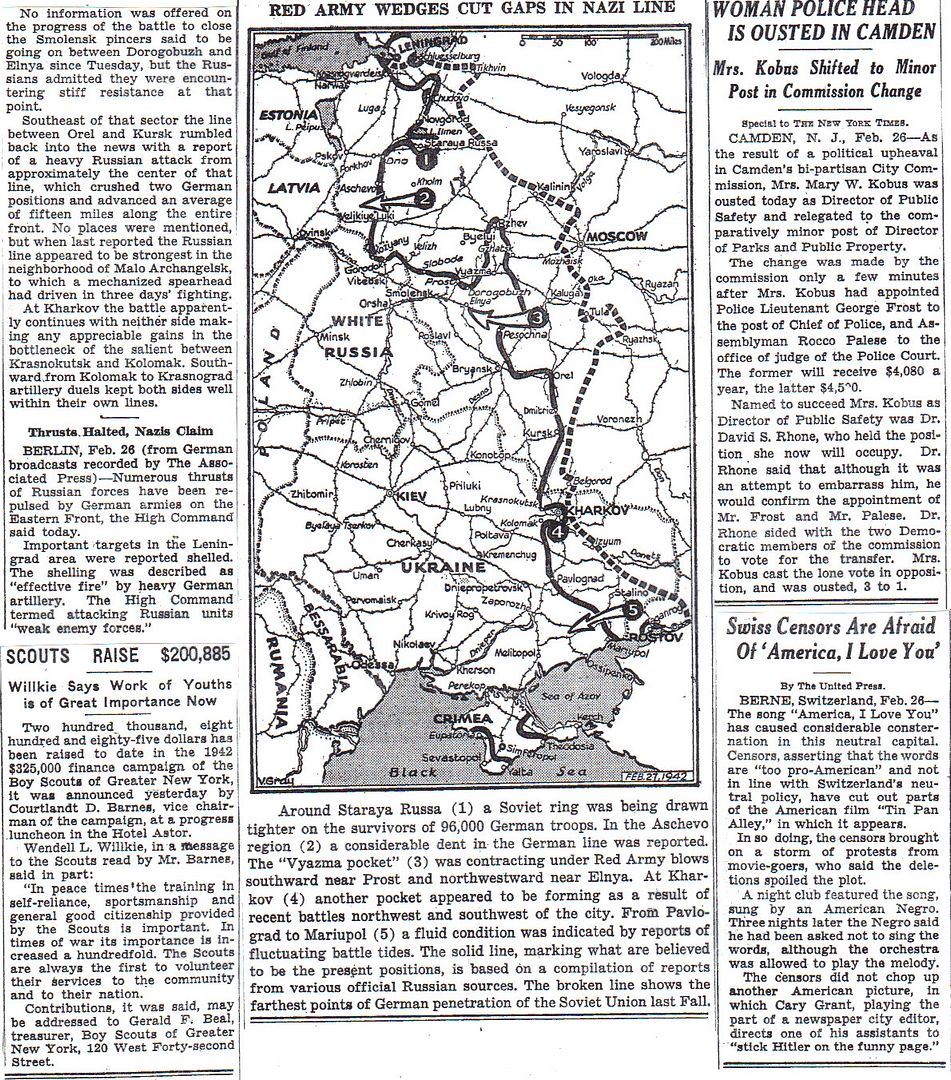
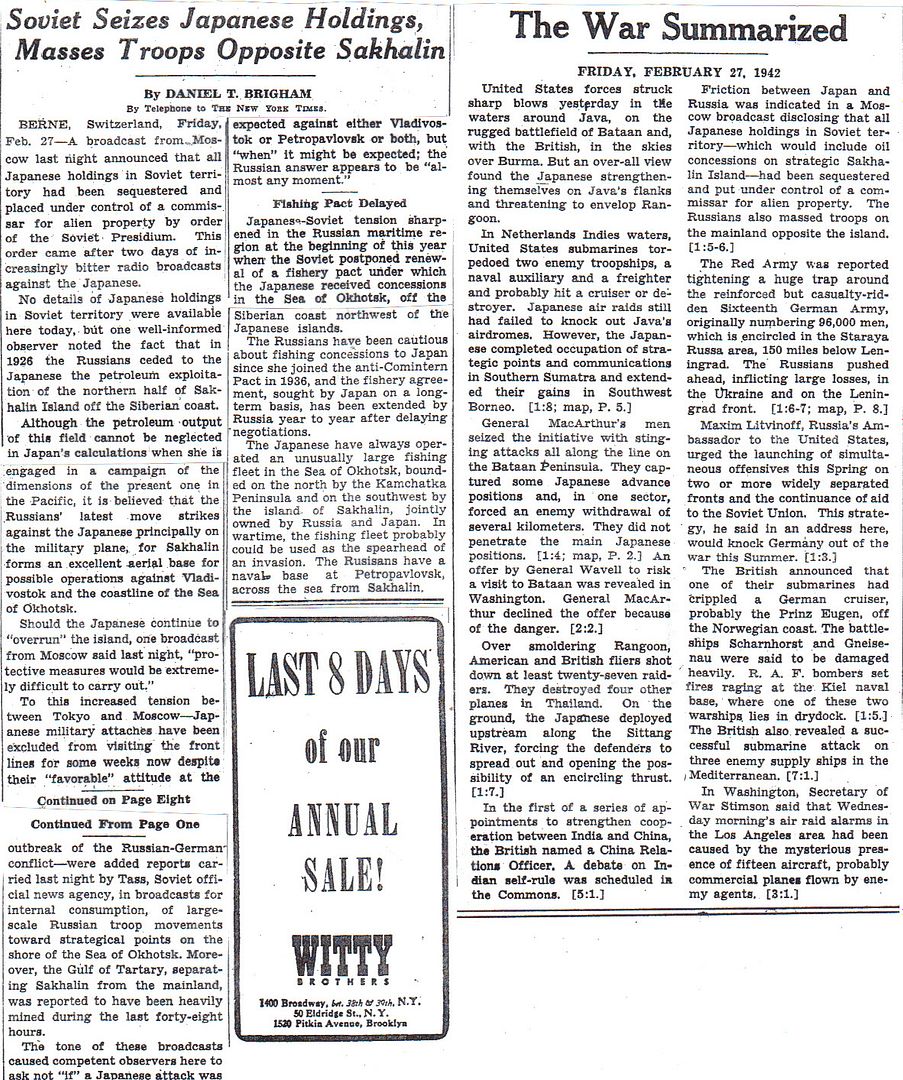
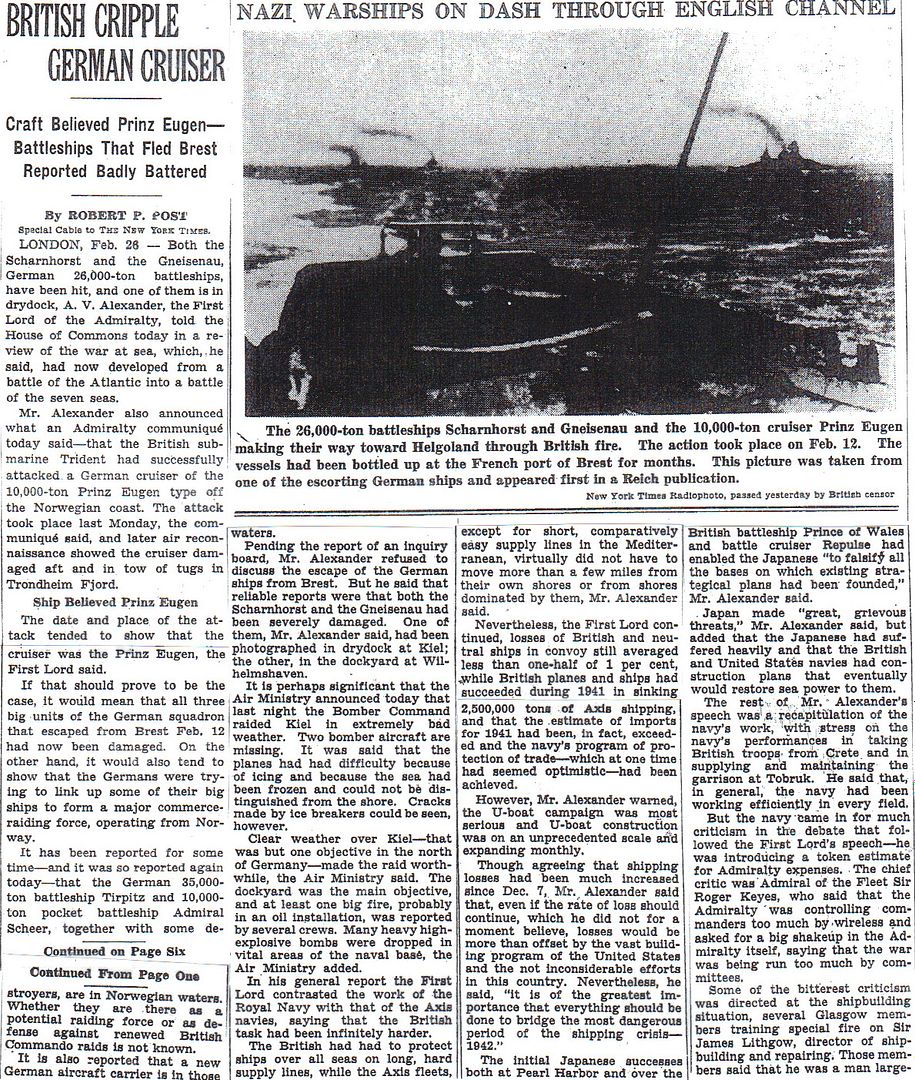
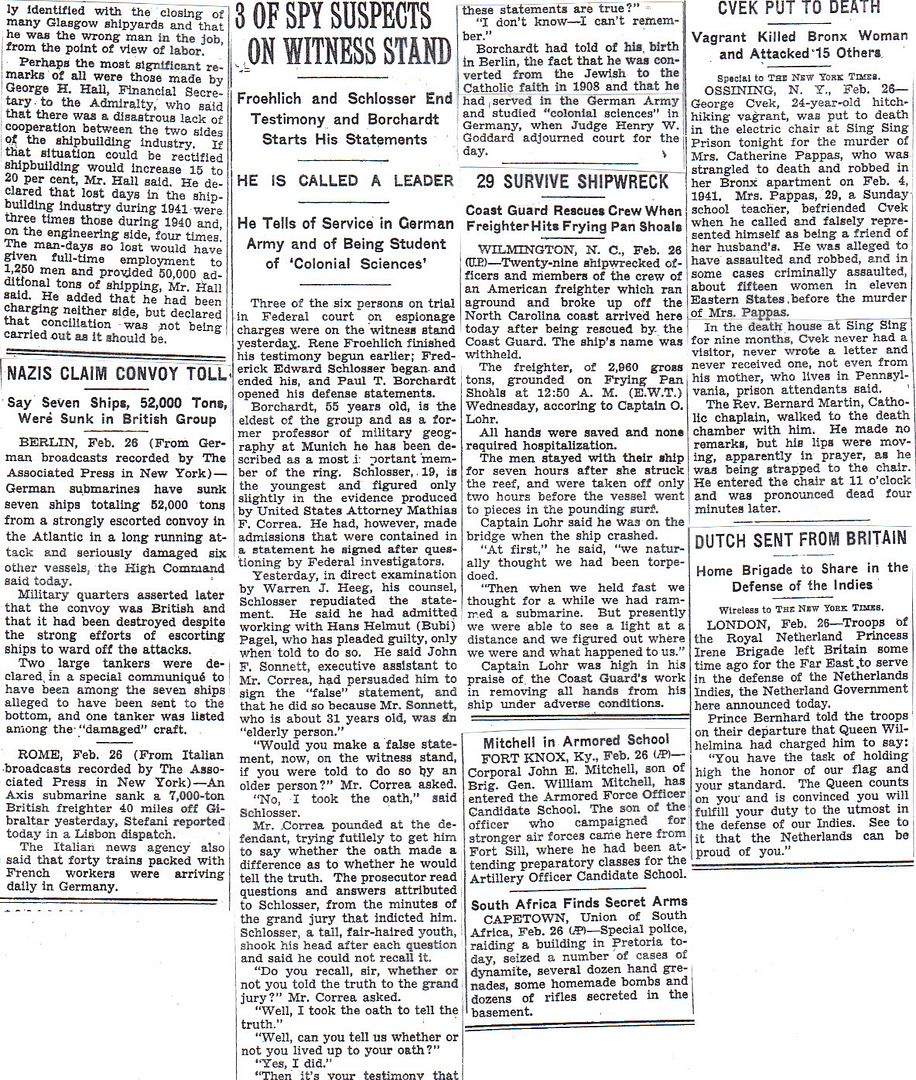

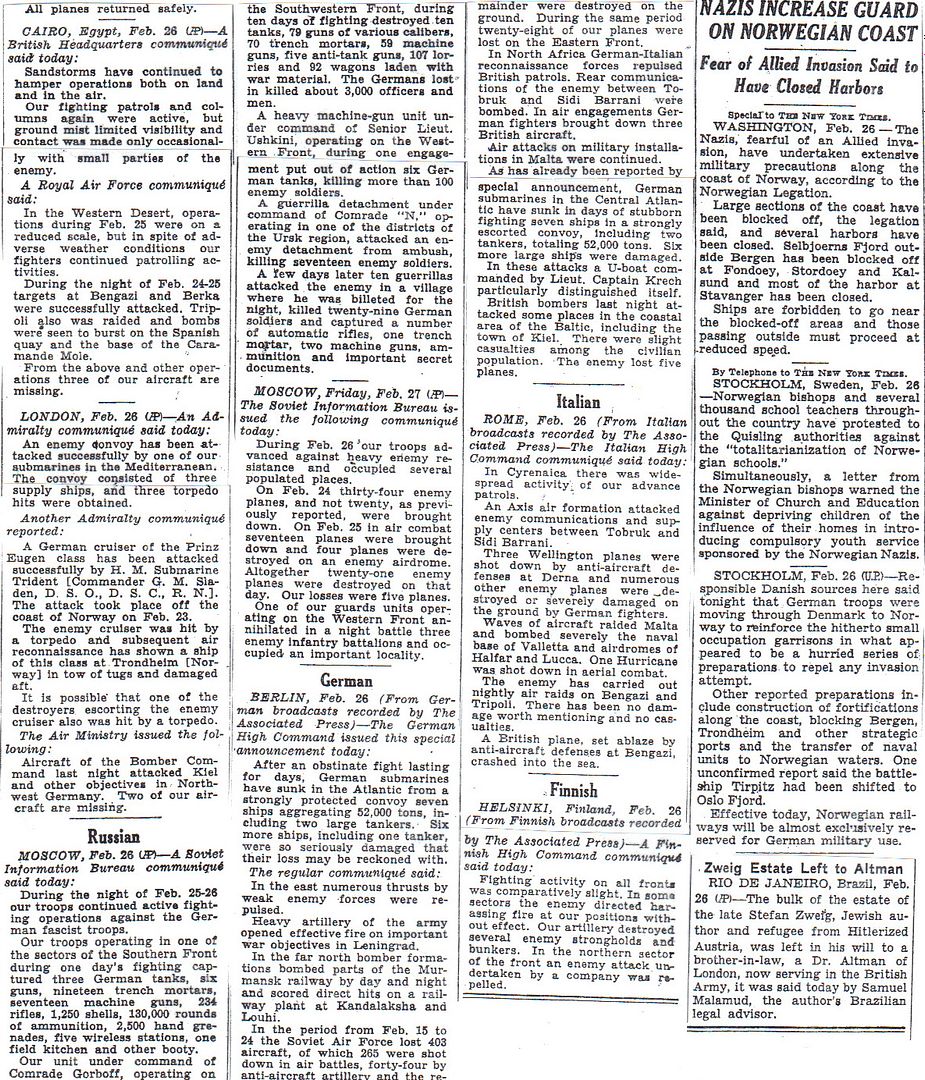
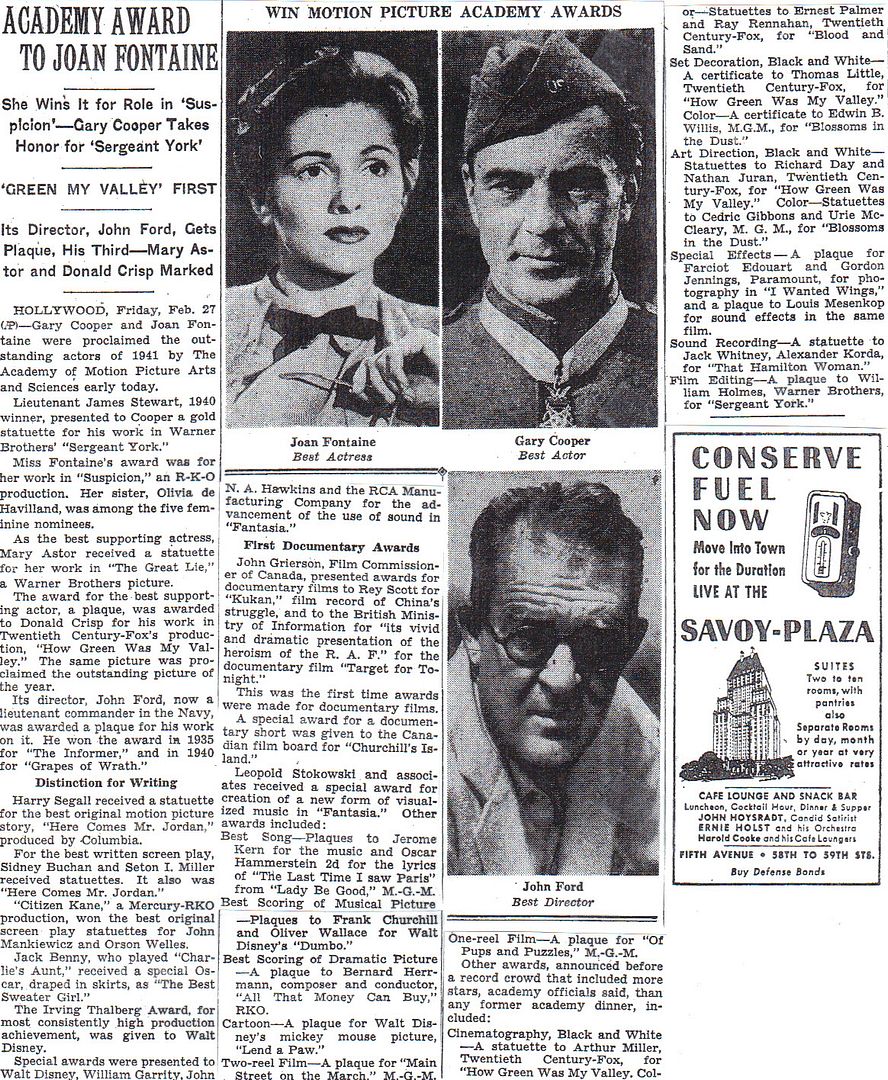
http://www.onwar.com/chrono/1942/feb42/f27feb42.htm
Allies engage Japanese in Java Sea
Friday, February 27, 1942 www.onwar.com
Propaganda poster exhorting the Dutch Navy to fightIn the Pacific... The Battle of the Java Sea. Allied Admiral Doorman commanding a four nation task force of five cruisers and eleven destroyers attempts to engage a Japanese invasion force commanded by Admiral Takagi on its way to Java. In a series of running engagements (February 27-28th), the Allied force is almost totally destroyed.
http://homepage.ntlworld.com/andrew.etherington/month/thismonth/27.htm
February 27th, 1942
UNITED KINGDOM: Anthony Eden, the foreign secretary, speculates in his diary that Churchill has had a stroke.
FRANCE: In a daring raid on France tonight Parachute Regiment soldiers seized top-secret German RDF (radar) equipment. The paras had been trained for this operation, jumping from their Whitley transports of No. 51 Squadron RAF (led by Wg./Cdr. P. C. Pickard, at night into snow near the clifftop target at Bruneval, near Le Havre.
The leader, Major John Frost, blew four blasts on his whistle to signal the attack and charged with four men through the front door of the enemy chateau overlooking the site, shooting as he went. Royal Engineers, guarded by paratroopers, tore out the aerial and other essential parts of the Würzburg tracking device with crowbars. Enemy bullets hit the equipment as they worked. For a time afterwards it seemed as if the escape route down a cliff to a beach rendezvous was blocked by a clifftop machine-gun post, whose bullets hit Sergeant-Major Strachan in the stomach. Then a team of paras which had landed off the drop zone joined the fight after a forced march. Hit by crossfire - and a Gaelic battle cry as the enemy attacked - the German gunners fled.
On the beach, survivors of the raid waited, but at first no-one responded to Frost’s signals calling in the boats. As his men prepared to fight to the last round, the word was passed: “The ruddy Navy’s here!” The paras embarked with the secret equipment and, as instructed, brought with them a captured RDF operator. They lost three dead and six captured.
Links1 Aerial photo of the Wurzburg Radar
Paris: Stülpnagel is succeeded as Military Governor of Paris (Militärefehlshaber) by his cousin, General Heinrich von Stülpnagel, transferred from the Wiesbaden Armistice Commission.
GERMANY: RAF Bomber Command fly three missions during the night of the 27th-28th: 68 aircraft, 33 Wellingtons, 17 Manchesters and 18 Hampdens, are dispatched to bomb the drydock at Kiel; the area is completely cloud-covered and only 50 aircraft bombed the approximate position of Kiel but, although Kiel reports hearing the planes, no bombs dropped in the town. No aircraft were lost. (2) In a second mission, 33 aircraft are dispatched to bomb the battleship Scharnhorst, which is believed to be at Wilhelmshaven, but the cloud was present here also; 26 aircraft drop their bombs but Wilhelmshaven reports only three bombs exploding, in the water of the harbor; three Whitleys are lost. (3) In the final mission, 11 Hampdens and four Manchesters lay mines in the Frisian Islands without loss. (Jack McKillop)
BAY OF BENGAL: Japan raids the Andaman Islands.
INDIA: General Archibald Wavell arrives in New Delhi from Java and assumes his post as Commander in Chief India. (Jack McKillop)
PACIFIC OCEAN: 9 Japanese bombers flying from Kendari find the carrier USS Langley (CV-1) in route to Tjilatjap. After 5 hits, the Langley is scuttled and survivors are rescued by the 2 destroyer escort. The Langley was ferrying 32 P-40 fighters for the defence of Java.
US freighter SS Sea Witch delivers 27 crated USAAF P-40s to Tjilatjap, Java, but the planes will be destroyed on the docks to deny their use by the Japanese.
USS Whipple (DD-217) and USS Edsall (DD-219) departed Tjilatjap to rendezvous with Langley (AV-3) off the south coast of Java. Making contact at 0629, the destroyers took up screening positions to escort the vulnerable Langley carrying a load of aircraft to bolster the sagging defenses of Java into Tjilatjap.
At 1150, lookouts spotted nine high-level bombers approaching from the east. Four minutes later, a stick of bombs splashed around Langley clearly the object of Japanese attention. During a second attack shortly after noon, all three ships put up brisk antiaircraft fire. At 1212, the Japanese, undaunted by Langley’s evasive manoeuvres, struck hard. A stick of bombs fell on or near the former aircraft carrier and set her afire.
Langley was abandoned at 1325, and Whipple proceeded close aboard to rescue survivors, using two of the destroyer’s life rafts, a cargo net slung over the side, and a number of lines trailed over the side. Staying some 25 yards off the sinking seaplane tender Whipple picked up some 308 men from Langley’s crew and embarked Army personnel for the vital P-40 fighters carried on the doomed ship’s abbreviated flight deck. At 1358, the task at hand completed, Whipple backed off and stood out to destroy the derelict, opening fire at 1429 with her 4-inch main battery. After nine rounds of 4-inch and two torpedoes, Langley settled lower and lower but refused stubbornly to sink. Soon orders arrived directing Whipple and her sister ship to clear the area prior to any more bombing attacks. Whipple accordingly vacated the vicinity and subsequently rendezvoused with Pecos (AO-6) in the lee of Christmas Island to transfer the Army pilots to the oiler. (Ron Babuka)
Dutch Admiral Karel Doorman leads a combined Dutch, British and US fleet against the Japanese forces arrayed for the invasion of Java. He is ordered to sea today from Surabaya to seek out and attack the Japanese convoy carrying the invasion force for Java, which was then off eastern Java. He has at his command cruisers HsMs De Ruyter, HMS Exeter, HMAS Perth, HsMs Java and USS Houston. Escorting this force are three British (HMS Electra, Jupiter and Encounter), two Dutch (Witte de With and Kortenaer) and four US destroyers (USS J.D.Edwards, Alden, John D. Ford and Paul Jones). The Japanese forces for the Battle of the Java Sea is commanded by Rear Admiral Takeo Takagi with heavy cruisers Nachi and Haguro, two light cruisers (Naka and Jintsu) and fifteen destroyers. The battle begins at 4:00 pm. For the first hour the Japanese destroyers are unsuccessful with their torpedoes and gunfire from their cruisers is ineffective. Likewise the ABDA force is ineffective. Destroyer HMS Electra is struck by 5-inch gunfire from the Japanese cruiser Asagumo and loses power shortly at 6.45pm. This is south-west of Bawean Island. 54 survivors are rescued by the US submarine S.38, but 90 die. Dutch destroyer Kortenaer sinks from a torpedo hit , which struck during the manoeuvring after the hit on Electra. There are 113 survivors. This happened at 5.35pm 43 miles south of Bawean Island with the torpedo coming from the Japanese cruiser Haguro. The action during the next 4 hours is uneventful. Manoeuvring to avoid the light of flares from Japanese aircraft at 9.20 pm the British destroyer HMS JUPITER hits a Dutch mine in the minefield Soerabaja, and sinks four hours later. Then at 11:30 pm as the two fleets run parallel 40 miles off Bawean Island, a wide spread of Japanese torpedoes from the Japanese cruisers Nachi and Haguro strike HsMs Java and HsMs De Ruyter sinking both. 344 men are lost in the DE RUYTER.
4.12pm: Fleets sight each other
4.16pm: Japanese open fire
4.17pm: Exeter opens fire
4.18pm: Houston opens fire
4.25pm: Perth opens fire on Japanese 4th Destroyer Flotilla
4.30pm: 1st Japanese torpedo attack 34 launched, no hits
4.31pm: DeRuyter hit in boiler room by 8-in shell, a dude, no damage
4.32pm: Japanese make smoke.
5.14pm: Exeter hit in boiler room by an 8-in shell from Nachi (Morison places the hit as coming from Haguro). six of eight boilers are put out of action. The ship hauls out of line, and the following ships interpret this as a formal manoeuvre and follow.
5.15pm: Japanese make second torpedo attack, 68 launched, one hit on the Kortenaer,
5.15pm: Kortenaer blows up, capsizes and sinks.
5.25pm: Perth and the British destroyer cover the withdrawal of Exeter with a torpedo attack through the smoke.
5.30pm: Electra is hit by Japanese gunfire, and left dead in the water.
5.25pm: Exeter withdraws, escorted by Witte de With.
5.30pm: Japanese continue to fire over the smoke, with aerial spotters.
5.40pm: The Fleets resight each other. 19,500 yard distant.
5.45pm: Japanese cruiser Haguro, hit by Perth. destroyer Asagumo is also left dead in the water.
5.50pm: Third Japanese torpedo attack, 24 are launch for no result.
6.00pm: Electra rolls over and sinks.
6.00pm: T.H. Binford, commander of the USN destroyer division makes a torpedo attack which scores no hits, while Doorman retires with the rest of the fleet.
6.30pm: contact lost.
7.27pm: Fleets find each other at a range of 9,000 yards.
7.33pm: Houston opens fire.
7.34pm: Japanese launch fourth torpedo attack, 4 only torpedoes, no hits
7.40pm: contact lost
9.00pm: The American destroyers, with no torpedoes left, broke off and headed for Surabaya to refuel.
9.25pm: Jupiter hits a mine, and is left dead in the water.
10.00pm: The fleet finds the survivors of Kortenaer in the water and Encounter picks up 113 men and returns to Surabaya.
10.55pm: Two Japanese cruisers close with the fleet.
11.00pm: Japanese launch 5th torpedo attack twelve are launched.
DeRuyter and Java are both hit multiple times
11.00pm: DeRuyter and Java both blow up and sink.
11.15pm: Waller, aboard Perth assumes command and retires. Perth and Houston make good their escape to Tanjong Priok The other ships, Exeter, Witte De With, Encounter and the four US Destroyers arrive at Surabaya. (Jim Patterson and Massimiliano Stola)
COMMONWEALTH OF THE PHILIPPINES: A Japanese force consisting of an infantry battalion and a field artillery battery lands at Calapan on north-eastern Mindora Island, and the town and airfield are overrun. No effort is made to secure the rest of the island. The Japanese blockade about the Philippines is thus tightened. (Jack McKillop)
JAVA SEA: Allied air and naval units try to stop a convoy of some 80 Japanese ships approaching Java from the northeast. All available USAAF B-17 Flying Fortresses, A-24 Dauntlesses, P-40s and LB-30 Liberators are put into the air but achieve only insignificant results. (Jack McKillop)
CANADA:
Corvette HMCS Chicoutimi departed Londonderry as escort for Convoy ON-71.
Corvette HMCS Rosthern departed Argentia with Convoy HX-177 to Londonderry. (Dave Shirlaw)
U.S.A.: President Franklin D. Roosevelt signs an executive order authorizing the creation of the Joint Mexican-U.S. defence Commission. (Jack McKillop)
Submarine USS Aspro laid down. (Dave Shirlaw)
ATLANTIC OCEAN: At 1035, SS Macgregor, dispersed from convoy ON-60, was sunk by gunfire by U-156 about 25 miles NW of Cape Viejos, Puerto Rico. One crewmember was lost. The master, 23 crewmembers and six gunners were picked up by a San Domingo Coast Guard cutter and landed at Puerto Plata, Dominican Republic.
At 0636, the unescorted tanker SS RP Resor was hit by one torpedo from U-578 about 20 miles east of Manasquan Inlet, New Jersey, while steaming blacked out on a zigzag course at 12.5 knots. The torpedo struck on the port side just forward of amidships and blew oil over the entire length of the ship and into the water. The oil ignited and flames rapidly spread 500 feet around the tanker as the eight officers, 33 crewmen and eight armed guards (the ship was armed with one 4in gun) tried to abandon ship. One boat with about 30 occupants was launched successfully but was soon engulfed in flames, other men perished as they tried to swim through the oil. One crewman and one armed guard were picked up by the US Coast Guard picketboat USS CG-4344 and landed at the Manasquan Coast Guard Station. The burning tanker stayed afloat until tug USS Sagamore attempted to salvage her. She capsized after the stern grounded in 122 feet of water and sank almost 48 hours after the torpedo hit about 31 miles east of Barnegat, New Jersey.
Destroyer USS Jacob Jones departed New York alone to patrol and search the area between Barnegat Light and Five Fathom Bank. She then received orders to concentrate her patrol activity in waters off Cape May and Delaware Capes. In the afternoon, the destroyer spotted the burning wreckage of the RP Resor, which had been torpedoed by U-578 the same day. The destroyer circled the tanker for two hours, searching for survivors before resuming her southward course.
At 0625, the unescorted and unarmed SS Marore was hit on the port side amidships by one torpedo from U-432 3.5 miles off Wimble Shoals. After 15 minutes, the eight officers and 31 crewmen abandoned ship in three lifeboats, just as the U-boat began shelling the ship until 0700. As the bulk carrier rolled over and slowly sank the U-boat left the area at 0720. A USCG motor surfboat from the Big Kinnakeet Lifeboat Station helped seven survivors from the third boat to get ashore, while USCGC CG-3843 rescued the master and 13 survivors from the same boat. The survivors in the other two boats were picked up by the John D. Gill and landed at Norfolk. The master, Charles Ernest Nash, experienced another sinking when his next ship, the Christopher Newport, was sunk in convoy PQ-17 on 4 Jul 1942. (Dave Shirlaw)
http://en.wikipedia.org/wiki/USS_Houston_%28CA-30%29
http://en.wikipedia.org/wiki/USS_Langley_%28CV-1%29
http://au.news.yahoo.com/thewest/a/-/breaking/13017563/survivors-recall-hmas-perth-loss/
Survivors recall HMAS Perth loss
http://www.perthone.com/perth.htm
http://en.wikipedia.org/wiki/HMAS_Perth_%28D29%29
http://www.navy.gov.au/HMAS_Perth_%28I%29
Note p8 article about New York killer being executed for a murder he committed 12 months earlier in Feb 1941.
“The burning tanker stayed afloat until tug USS Sagamore attempted to salvage her. She capsized after the stern grounded in 122 feet of water and sank almost 48 hours after the torpedo hit about 31 miles east of Barnegat, New Jersey.”
It’s difficult to imagine ships being sunk just 31 miles from New Jersey. Pretty bold of the Germans to be so close.
IIRC, over fifty ships were sunk by U-boats in the Gulf of Mexico, and another dozen or so made it back to port with damage. Only one U-boat was lost in those waters. Yes, the Germans were quite bold, especially in 1941 - 1942.
http://en.wikipedia.org/wiki/USS_Langley_(CV-1)
“A relatively unique feature of Langley was provision for a carrier pigeon house on the stern between the 5 in (130 mm)/51 cal guns.[15] Pigeons had been carried aboard seaplanes for message transport since World War I, and were to be carried on aircraft operated from Langley.[15] The pigeons were trained at the Norfolk Naval Shipyard while Langley was undergoing conversion.[16] As long as the pigeons were released a few at a time for exercise, they returned to the ship; but when the whole flock was released while Langley was anchored off Tangier Island, the pigeons flew south and roosted in the cranes of the Norfolk shipyard.[16] The pigeons never went to sea again and the former pigeon house became the executive officer’s quarters;[15] but the early plans for conversion of Lexington and Saratoga included a compartment for pigeons.”[
Carrier pigeons indeed held a niche in the long history of human intercommunication.
http://en.wikipedia.org/wiki/Paul_Reuter
After the failed Revolution of 1848, Reuter fled from Germany and went to Paris and worked there in Charles-Louis Havas’ news agency, the future Agence France Presse. While telegraphy evolved, Reuter first founded the Reuters News Agency in Aachen which transferred messages between Brussels and Aachen using carrier pigeons. This was the missing link to connect Berlin and Paris. The carrier pigeons were much faster than the post train, giving Reuter faster access to stock news from the Paris stock exchange. In 1851, the carrier pigeons were superseded by a direct telegraph link.
I love Joan Fontaine. She’s still alive too.
In case you missed it you might be interested in a review of “Rebecca” from 1940. March 29, 1940, to be precise. There was discussion of Miss Fontaine’s trademark twin sweaters.
Homer I appreciate that link because that film is the reason I like her so much. Thanks.
Disclaimer: Opinions posted on Free Republic are those of the individual posters and do not necessarily represent the opinion of Free Republic or its management. All materials posted herein are protected by copyright law and the exemption for fair use of copyrighted works.